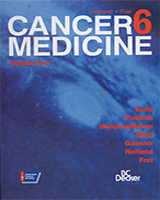By agreement with the publisher, this book is accessible by the search feature, but cannot be browsed.
NCBI Bookshelf. A service of the National Library of Medicine, National Institutes of Health.
Kufe DW, Pollock RE, Weichselbaum RR, et al., editors. Holland-Frei Cancer Medicine. 6th edition. Hamilton (ON): BC Decker; 2003.

Holland-Frei Cancer Medicine. 6th edition.
Show detailsHuman chemical carcinogenesis is a multistage process that results from exposures, usually in the form of complex chemical mixtures, often encountered in the environment or through our lifestyle and diet (Table 17-1).1–4 A prime ex-ample is tobacco smoke, which can cause cancers of the lung, bladder and head, and neck.5,6 Although most chemical carcinogens do not react readily with nucleophilic biochemicals, they are activated to carcinogenic and mutagenic electrophiles by metabolic processes evolutionarily designed to rid the body of toxins and to modify endogenous compounds. Electrophilic chemical species are naturally attracted to nucleophiles like DNA and protein, and through covalent bonding to deoxyribonucleic acid (DNA) genetic damage results. Once internalized, carcinogens are subject to competing processes of metabolic activation and detoxication, although some chemical species can act directly. There is considerable variation among the human population in these competing metabolic processes, as well as the capacity for repair of DNA damage and cellular growth control. This is the basis for interindividual variation in cancer risk, and is a reflection of gene-environment interactions, which embodies the concept that heritable traits modify the effects of chemical carcinogen exposure.7 Such variations in constitutive metabolism and DNA repair contribute to the relative susceptibility of individual members of the population to chemical exposures. For example, only 10% of tobacco smokers develop lung cancer, albeit that tobacco use accounts for other fatal conditions, including heart disease. Within the conceptual framework of multistage carcinogenesis, the initial genetic change that results from chemical-DNA interaction is termed tumor initiation.8,9 Thus, initiated cells are irreversibly altered and are at a greater risk of malignant conversion than are normal cells. The epigenetic effects of tumor promoters facilitate the clonal expansion of the initiated cells.9 Selective, clonal growth advantage causes a focus of preneoplastic cells to form. These cells are more vulnerable to tumorigenesis because they now present a larger, more rapidly proliferating, target population for the further action of chemical carcinogens, oncogenic viruses, and other cofactors. Additional genetic changes continue to accumulate. The activation of oncogenes, and the inactivation of tumor suppressor and DNA-repair genes, leads to genomic instability or the so called mutator phenotype and an acceleration in the genetic changes taking place.10,11 This scenario leads to malignant conversion, tumor progression, and metastasis. The underlying molecular mechanisms that govern chemical carcinogenesis are becoming understood, and the insights generated are assisting in the development of better methods to investigate human cancer risk and susceptibility.12 The results of such studies are intended to mold strategies for prevention and intervention. Moreover, insights into the normal operations of so-called gatekeeper genes,13 like the tumor suppressor p53, have provided an opportunity to develop new, targeted, therapeutic approaches.14
Table 17-1
Selected Examples of Human Chemical Carcinogenesis.
Contents
- Multistage Carcinogenesis
- Gene-Environment Interactions and Interindividual Variation
- Carcinogen Metabolism
- DNA Damage and Repair
- Mutator Phenotype
- Clonal Evolution
- Oncogenes and Tumor-Suppressor Genes
- Assessment of Causation by the Bradford-Hill Criteria
- Implications for Molecular Epidemiology, Risk Assessment, and Cancer Prevention
- Acknowledgments
- References
- Chemical Carcinogenesis - Holland-Frei Cancer MedicineChemical Carcinogenesis - Holland-Frei Cancer Medicine
Your browsing activity is empty.
Activity recording is turned off.
See more...